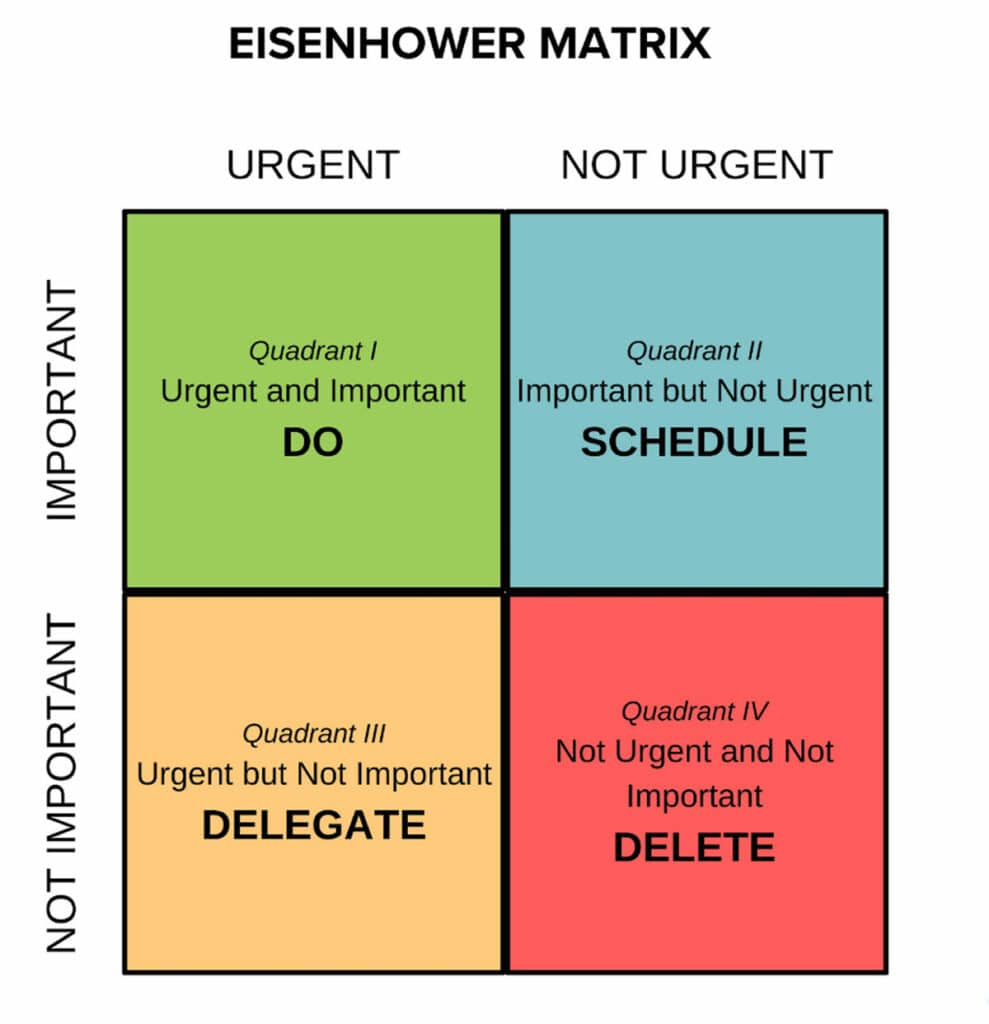- The Eisenhower Matrix, inspired by Dwight D. Eisenhower and Dr. J. Roscoe Miller, revolutionizes task prioritization by categorizing activities based on urgency and importance.
- The four quadrants – DO, SCHEDULE, DELEGATE, and DELETE – provide a practical framework for learners to optimize time management and focus efforts on tasks contributing to both personal and academic success.
- Scheduling regular reviews, setting realistic time limits, and combining personal and school tasks provide actionable strategies for enhancing the matrix’s effectiveness and achieving work-life balance.
- The matrix is flexible and useful in a variety of contexts, including the workplace, classroom, and personal life.
Do the urgent or prioritize the important? At some point, we’ve all been there, faced with the dilemma of figuring out what deserves the top spot on our to-do list. It’s a head-scratcher that often leaves us contemplating. However, spending too much time thinking about this choice can ironically eat into the time we should already be dedicated to actually doing the tasks.
The challenge often lies in task prioritization and effectively assigning responsibilities based on their level of importance and what needs immediate attention. One standout method for prioritizing tasks is the Eisenhower Matrix, which finds application not only in the corporate world but also in education and even in our everyday lives. Its simplicity and practicality make it a handy tool for enhancing productivity. Named after Dwight D. Eisenhower, the 34th President of the United States, this matrix became a well-known approach to categorizing tasks by urgency and importance.
In this article, we will talk about the matrix’s history and definition, as well as how its four distinct quadrants can help you. It will also show you how to easily incorporate it into your study routine, weigh its pros and cons, and give you useful tips on how to master this method to get the most out of it.
The SOAR Method
The history of the Eisenhower Matrix
From being a five-star general in World War II to his time as president, Dwight D. Eisenhower had a timeless principle that had a huge influence on him and his acclaimed organizational and time management skills. It was inspired by Dr. J. Roscoe Miller, president of Northwestern University, and he quoted him in a 1954 speech:
I have two kinds of problems: the urgent and the important. What's important is never urgent, and what's urgent is never important.
Dr. J. Roscoe Miller
This speech gave birth to a highly valuable tool for time management and task prioritization, the Eisenhower Matrix. Although Eisenhower was partially responsible for coming up with the matrix idea, the concept itself was the product of the combined insight of a large number of industry experts. In particular, it was made famous by Stephen R. Covey when it was mentioned in his best-selling book, The 7 Habits of Highly Effective People, one of the most influential business books ever written.
Since then, it has been used for years to help people improve their personal and professional lives. So, despite its somewhat vague origins, the Eisenhower matrix changed how people manage their time and work by categorizing tasks by urgency and importance, making them more productive in many areas.
The 4 quadrants of the Eisenhower Matrix
In the Eisenhower matrix, urgency and importance are the key criteria, guiding learners to distinguish between tasks that demand immediate attention and those that align with broader objectives. By systematically organizing responsibilities, the matrix empowers learners to optimize their time and concentrate efforts on activities that contribute significantly to both personal and academic success.
This practical framework for task prioritization divides activities into four distinct quadrants, each representing a different combination of urgency and importance:

Quadrant I - Urgent and Important: DO
These tasks are both important to your goals and need to be done right away. They need your immediate attention and usually include important tasks with due dates, emergencies, or important issues. These are the tasks that you should immediately do.
Quadrant II - Important but Not Urgent: SCHEDULE
Quadrant II tasks are important but not urgent for long-term goals. These tasks help you achieve goals and well-being without deadlines. It includes proactive planning, personal growth, relationship-building, and strategic goals. These are the tasks that you can schedule and spread out on your calendar.
Quadrant III - Urgent but Not Important: DELEGATE
Tasks in this quadrant are urgent but do not significantly contribute to long-term goals. These jobs can often be given to other people. Examples include unnecessary meetings, emails, and urgent interruptions that don’t support important goals. These are the tasks that you should delegate.
Quadrant IV - Not Urgent and Not Important: DELETE
Quadrant IV includes tasks that are neither urgent nor important. These low-priority tasks may waste time or distract you. For optimal productivity, minimize or eliminate time spent in this quadrant. These are the tasks that you should not do or just delete from your to-do list.
Take a look at these example tasks and activities in the Eisenhower matrix to get a better idea of how to plan your schoolwork and know what to do first.

Steps in using the Eisenhower Matrix
Now that you’re already familiar with the four quadrants and what to put in each one, let’s start managing tasks by combining their level of importance and urgency. Simply follow these steps to make use of the Eisenhower Matrix:
Write down your tasks.
Create a list of all the things you need to do. This includes anything that requires your attention, including work-related and personal obligations.
Assess their urgency and importance.
Estimate the degree of urgency and significance associated with each task. Remember that urgency relates to how quickly something needs to be done, while importance means how it will affect your long-term goals.
Put tasks in their respective quadrants.
Classify each task into its corresponding quadrant according to your evaluation of its urgency and importance.
Prioritize within each quadrant.
Prioritize tasks further within each quadrant based on their specific urgency or importance. This step helps you start with the most important tasks.
Take action.
Once tasks are categorized and prioritized, it’s time to take action. Start with Quadrant I tasks that need immediate attention. Then, you can consider delegating the tasks in Quadrant III to the right people before moving on to Quadrant II so that while you’re doing your scheduled tasks, others in your team are also making productive gains from their time.
Review and adjust.
Review and adjust matrix tasks regularly. You may need to reevaluate the urgency and importance of tasks as priorities and deadlines change. Consider rearranging your Eisenhower weekly or whenever you need to add tasks.
The advantages and disadvantages of the Eisenhower Matrix
The Eisenhower Matrix can help learners improve their time management and productivity, but like any other method, it has its own drawbacks. Before using this study method, consider these pros and cons.
Advantages:
- The matrix prioritizes urgent tasks while also allocating time for long-term goal development.
- Prioritizing urgent tasks and planning for non-urgent ones reduces stress and improves control.
- The matrix encourages smart decision-making by ranking tasks according to their level of urgency and significance.
- Keeping everyday activities in line with overall objectives guarantees that time is spent on activities that advance both academic and personal success.
- Reduces procrastination and last-minute rushes by encouraging early task completion.
- Setting priorities helps you balance your school and personal lives by giving time for both short-term needs and long-term goals.
Disadvantages:
- The matrix may either oversimplify or overcomplicate some tasks, especially those that fall somewhere in the middle of the urgency/importance spectrum.
- Personal judgment determines task classification, so matrix interpretation and use vary.
- Tasks that become urgent due to unanticipated events may be overlooked.
- As effective delegation requires trust, communication, and appropriate team dynamics, assigning work in Quadrant III can be difficult for some people.
- Too much categorization can cause overthinking, where you spend more time evaluating than doing.
Tips for using the Eisenhower Matrix
Improve your experience with the Eisenhower matrix by following these tips and achieve a more balanced and effective approach to learning.
- Review and update matrix task categorizations to adapt to changing priorities, stay on track, and avoid overanalyzing tasks. Schedule a weekly Eisenhower Matrix review and planning day. This creates a routine for proactive task management.
- Set reasonable time limits. This makes it easier to finish tasks quickly and keeps you from taking on too many urgent tasks at once.
- Use the Pomodoro technique or the Flowtime method (focused, timed intervals) in each quadrant to stay focused, avoid getting tired, and make sure you make progress on your work.
- Apply the Pareto principle (80/20 rule) to each quadrant to identify and prioritize tasks that most affect your goals. This ensures that you allocate your energy to activities that bring the most significant results.
- Change the matrix to fit your needs and the way you work. You can find digital templates online, like the Asana Eisenhower matrix, to make things easier. You can also make your own in programs like Microsoft Excel or Google Sheets. By using different colors, you can make them more useful and unique for you.
- Keep things in balance by putting both personal and schoolwork in your matrix. Make time for personal activities so that you don’t just work on schoolwork. This will help you make sure that your weekly priorities are well-rounded.
- Observe your progress and accomplishments. Reward yourself for finishing tasks and use the knowledge gained from your successes to improve your strategy for using the matrix over time.
Conclusion
The Eisenhower Matrix goes beyond traditional methods of time management in order to direct conscious decision-making and setting of priorities. Because of its versatility, it helps professionals manage projects, entrepreneurs run successful businesses, and students maintain a healthy balance between their personal and academic obligations. Incorporating it into your daily routine may allow you to feel less overwhelmed, get more things done, and get a better balance between what is most pressing and what can wait.
Regardless of its drawbacks, you can get the most out of it by seeing the matrix as a guideline that can be changed to fit your needs and the situation. When you combine it with other productivity tools, it can create a holistic approach to handling your tasks that helps you reach your short and long-term personal and academic goals.



